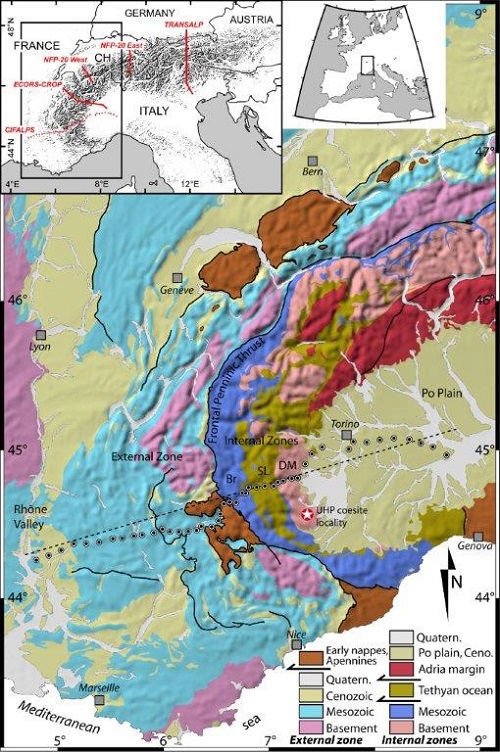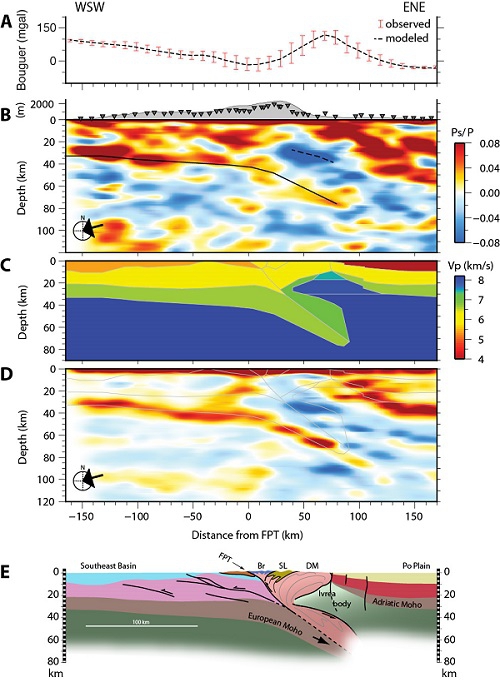|
Secondary Ion Mass Spectrometer Laboratory
|
Press
Joint Chinese-French-Italian research identifies the seismic signature of continental crust subducting under the AlpsThe subduction of continental lithosphere in the mantle has long been considered as impossible because of the floating force of continental crust. The first conclusive evidence in support of burial of continental crust to depths >90 km was provided by the discovery of coesite-bearing metamorphic rocks in the Dora Maira massif of the Western Alps by French petrologist, Chopin in 1984. Since then, even though similar outcrops of exhumed high-pressure to ultra-high pressure rocks have been recognized worldwide, direct seismic evidence for subduction of continental crust in the mantle of the upper plate remains rare. Such conclusive evidence for the burial of the European crust below the Adriatic mantle is lacking for the Alpine belt. From 2010 to 2013 year, the State Key Laboratory of Lithospheric Evolution, Institute of Geology and Geophysics, Chinese Academy of Sciences(IGGCAS) has organized an international cooperation project in the Alps with the Université Grenoble Alpes, ISTerre, Grenoble, France and the Istituto Nazionale di Geofisica e Vulcanologia, Genova, Italy. This project, named "China-Italy-France Alps Seismic survey (CIFALPS)", deployed the first passive seismic array (recording earthquake signals) that cross-cuts the entire western Alps. Using CIFALPS data, for the first time, the CIFALPS team provides geophysical images for continental crust at 75 km in depth that is clearly connected with the European crust exactly along the transect where ultra-high pressure minerals were found at the surface. They also provide evidence for a thick boundary zone beneath which the seismic velocity decrease with depth. This reverse anomaly of velocity demonstrates that the European lower crust sunk into the Adriatic mantle. These findings in the Alps (one of the best preserved and long studied ultra-high pressure orogens worldwide) shed decisive new light on geodynamic processes along collisional continental margins.
Figure 1. Location of the seismic array on a geological map of the Western Alps. Black circles show seismic stations; dashed line is reference profile used in projections. Large inset: Locations of the previous main seismic experiments in the Alps. Small inset: Location of the study area. CH—Switzerland; UHP—ultrahigh pressure; NFP—Nationales Forschungsprogramm (Swiss National Science project); CIFALPS—China-Italy-France Alps seismic survey; Br—BrianÇonnais; DM—Dora Maira; SL—schistes lustrés; Quatern.—Quaternary; Ceno.—Cenozoic.
Figure 2. Common conversion point (CCP) migrated depth section projected onto the reference profile (Fig. 1). A: Observed (for details, see the Data Repository [see footnote 1]) and modeled (as indicated) Bouguer gravity anomaly. B: CCP depth section computed from teleseismic events in the northeast quadrant. Positive and negative Ps phases are shown in red and blue, respectively, according to color scale (right). Continuous black line is the European Moho. Dashed black line is the inverted Moho. Topography (gray-filled curve) and station locations (black inverted triangles) are shown at top. C: Preferred two-dimensional velocity and gravity model. Density scale is proportional to the velocity (Vp) scale (Fig. DR4; see footnote 1). D: Synthetic CCP depth section computed for the preferred model and northeast backazimuths. The layer boundaries of the input model are shown (light gray lines). E: Interpretation of the crustalscale geological cross section, using the same color legend as in Figure 1. Arrows in B and D indicate range of event backazimuths (28°–118°) used in CCP stacking. Br—BrianÇonnais; DM—Dora Maira; FPT—Frontal Penninic thrust; SL—schistes lustrés. This work, lead by Zhao Liang from IGG, was recently published in Geology: Zhao, L., Paul, A., Guillot, S., Solarino, S., Malusà, M.G., Zheng, T., Aubert, C., Salimbeni, S., Dumont, T., Schwartz, S., Zhu, R., Wang, Q., 2015. First seismic evidence for continental subduction beneath the Western Alps. Geology, 43, 815-818, doi: 10.1130/g36833.1. (Full text) Contact:
|
-
SIMSSecondary Ion Mass Spectrometer Laboratory
-
MC-ICPMSMultiple-collector ICPMS Laboratory
-
EM & TEMElectron Microprobe and Transmission Electron Microscope Laboratory
-
SISolid Isotope Laboratory
-
StIStable Isotope Laboratory
-
RMPARock-Mineral Preparation and Analysis
-
AAH40Ar/39Ar & (U-Th)/He Laboratory
-
EMLElectron Microscopy Laboratory
-
USCLUranium Series Chronology Laboratory
-
SASeismic Array Laboratory
-
SEELaboratory of Space Environment Exploration Laboratory
-
PGPaleomagnetism and Geochronology Laboratory
-
BioMNSFrance-China Bio-mineralization and Nano-structure Laboratory



